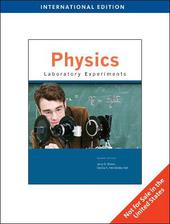
|
Physics Laboratory Experiments, International Edition
Paperback
Main Details
| Title |
Physics Laboratory Experiments, International Edition
|
| Authors and Contributors |
By (author) Jerry Wilson
|
|
By (author) Cecilia A. Hernandez-Hall
|
| Physical Properties |
| Format:Paperback | | Pages:544 | | Dimensions(mm): Height 278,Width 217 |
|
| Category/Genre | Physics |
|---|
| ISBN/Barcode |
9781439049129
|
| Classifications | Dewey:530.078 |
|---|
| Audience | | Professional & Vocational | |
|---|
| Edition |
7th edition
|
|
Publishing Details |
| Publisher |
Cengage Learning, Inc
|
| Imprint |
Brooks/Cole
|
| Publication Date |
11 June 2009 |
| Publication Country |
United States
|
Description
This market-leading manual for the first-year physics laboratory course offers a wide range of class-tested experiments designed specifically for use in small to mid-size lab programs. A series of integrated experiments emphasizes the use of computerized instrumentation and includes a set of "computer-assisted experiments" to allow students and instructors to gain experience with modern equipment. This option also enables instructors to determine the appropriate balance between traditional and computer-based experiments for their courses. By analyzing data through two different methods, students gain a greater understanding of the concepts behind the experiments. The Seventh Edition is updated with the latest information and techniques involving state-of-the-art equipment, and a new Guided Learning feature addresses the growing interest in guided-inquiry pedagogy. Fourteen additional experiments are also available through custom printing.
Author Biography
Cecilia Hernandez-Hall received her M.S. in physics from the University of Puerto Rico, Mayaguez Campus, in 1993. After teaching for two years at the Mayaguez and Cayey campuses, she joined the Physics Education Research Group at the University of Nebraska, Lincoln, where research in physics education was conducted with an emphasis on computerized instruction. Professor Hernandez has used computerized instruction with hundreds of her students, and she contributes to the computerized-instruction material throughout PHYSICS LABORATORY EXPERIMENTS. In 1998, Professor Hernandez joined the faculty of American River College. She also works for PASCO Scientific in Roseville, California, where she helps develop computer-assisted lab activities for college physics and write manuals for new equipment. Jerry Wilson received his physics degrees from Ohio University (B.S., Ph.D.) and Union College in Schenectady, New York (M.S.). In addition to co-writing PHYSICS LABORATORY EXPERIMENTS, he is one of the original authors of the first edition of AN INTRODUCTION OF PHYSICAL SCIENCE (published in 1971) and has several other physics textbooks to his credit. Wilson is currently Emeritus Professor of Physics at Lander University in Greenwood, South Carolina.
ReviewsNote: Experiments that incorporate both traditional and computerized instruction are denoted with a "TI/CI" abbreviation. In some instances, the TI and CI components are not the same, so the title for each component is listed separately. The "GL" abbreviation precedes experiments that feature a Guided-Learning format. Experiments without an accompanying abbreviation only involve traditional instruction. Experiments available in bound volume: 1. Experimental Uncertainty (Error) and Data Analysis. 2. Measurement Instruments (Mass, Volume, and Density). 3. (GL) The Scientific Method: The Simple Pendulum. 4. (TI-GL/CI) Uniformly Accelerated Motion (Includes TI free-fall spark timer apparatus method at end of experiment). 5. The Addition and Resolution of Vectors: The Force Table. 6. (TI-GL/CI) Newton's Second Law: The Atwood Machine. 7. (TI/CI) Conservation of Linear Momentum. 8. (GL) Projectile Motion: The Ballistic Pendulum. 9. Centripetal Force. 10. (TI/CI) Friction. 11. (GL) Work and Energy. 12. (GL) Torques, Equilibrium, and Center of Gravity. 13. (GL) Simple Machines: Mechanical Advantage. 14. (TI/CI) Simple Harmonic Motion. 15. Standing Waves in a String. 16. The Thermal Coefficient of Linear Expansion. 17. Specific Heats of Metals. 18. Archimedes' Principle: Buoyancy and Density. 19. Fields and Equipotentials. 20. (TI/CI) Ohm's Law. 21. The Measurement of Resistance: Ammeter-Voltmeter Method and Wheatstone Bridge Method. 22. The Temperature Dependence of Resistance. 23. (TI/CI) Resistances in Parallel and Series. 24. Joule Heat. 25. The RC Time Constant (Manual Timing). 26. (TI/CI) The RC Time Constant (Electronic Timing). 27. Reflection and Refraction. 28. Spherical Mirrors and Lenses. 29. (TI) Polarized Light; (CI) Malus's Law. 30. The Prism Spectrometer: Dispersion and Index of Refraction. 31. Line Spectra and Rydberg Constant. 32. (TI) The Transmission Grating: Measuring the Wavelengths of Light; (CI) Single-Slit and Double-Slit Diffraction. 33. Detection of Nuclear Radiation: The Geiger Counter. 34. Radioactive Half-Life. 35. The Absorption of Nuclear Radiation. Experiments available only in customized orders: 36. (TI/CI) Rotational Motion and Moment of Inertia. 37. Conservation of Angular Momentum and Energy: The Ballistic Pendulum. 38. Elasticity: Young's Modulus. 39. Air Column Resonance: The Speed of Sound in Air. 40. (TI) Latent Heats: Heats of Fusion and Vaporization of Water; (CI) Latent Heat of Fusion for Water. 41. Newton's Law of Cooling: The Time Constant of a Thermometer. 42. The Potentiometer: emf and Terminal Voltage. 43. The Voltmeter and Ammeter. 44. Resistivity. 45. Multiloop Circuits: Kirchhoff's Rules. 46. The Earth's Magnetic Field. 47. Introduction to the Oscilloscope. 48. (TI/CI) Phase Measurements and Resonance in ac Circuits. 49. (TI/CI) Electromagnetic Induction. 50. The Mass of an Electron: e/m Measurement.
|